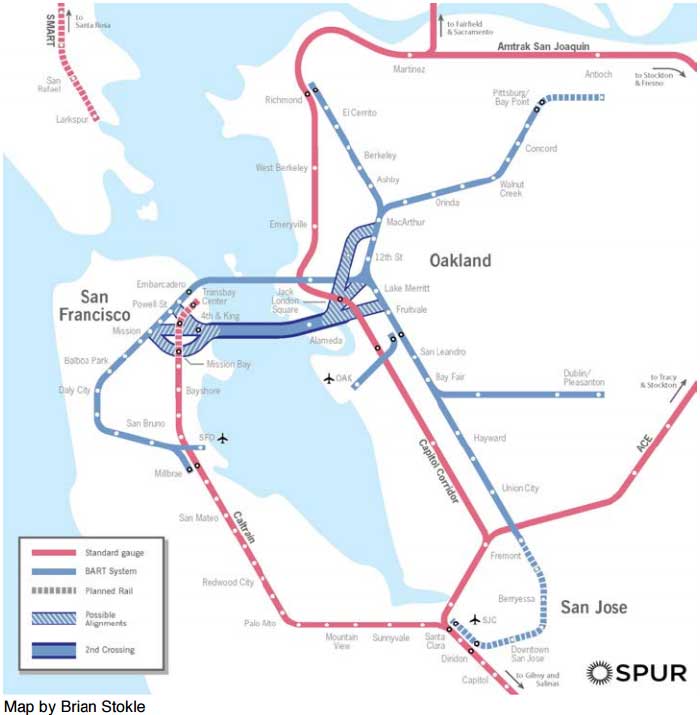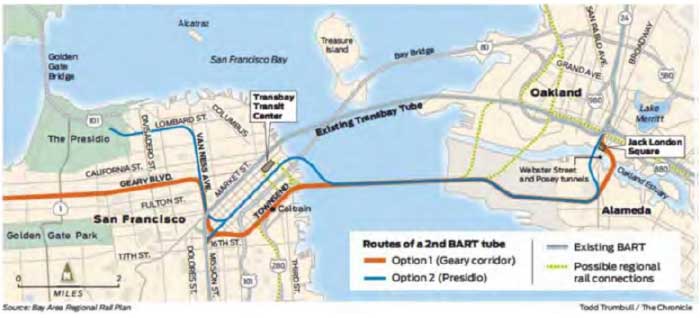There is a growing consensus that building a second Transbay Tube is critical to the Bay Area’s future. Transbay ridership has skyrocketed in recent years – MTC’s ongoing Core Capacity Study estimates that peak hour Transbay transit capacity operated at 96 percent capacity in 2014, and ridership has continued to increase since then despite extremely crowded trains and buses.
Advocacy groups including SPUR and the Bay Area Council have recently published reports articulating the need for a second tube. While there are several other critical improvements that can increase Transbay capacity by at least 33 percent in the interim, including upgrades to BART’s infrastructure and improvements to Transbay bus and ferry service, these improvements still may not adequately address the capacity needs a decade from now.
Unfortunately, Bay Area transportation leaders have not been proactive in planning for a second tube: BART’s possible ballot measure, for example, will not include any funding toward a second tube despite broad support. Therefore, while the need for a second tube is widely acknowledged, there is little certainty around what form the multi-billion dollar project could take. SPUR’s new report presents a comprehensive range of options, but each presents challenges.
BART Gauge, Standard Gauge, or Both?
The first question for a second Transbay Tube is what type of rail gauge should it serve? The Bay Area presently includes two incompatible types of rail systems: Caltrain and Amtrak (Capitol Corridor, etc.), which is standard gauge, and BART, which is a custom wide gauge. SPUR outlines three options: BART gauge, standard gauge, and a combined four track tube with both gauges.
A BART gauge tube would strengthen the existing BART system and offer operational flexibility as trains could run through either tube. This option would increase BART’s reliability: if the Tube experiences a problem today, it reverberates through the entire system. It would also allow for late night service, which is currently infeasible due to maintenance needs. However, a BART-only tube by itself would not significantly expand BART’s service area or regional transit connectivity.
Standard gauge rail would offer expanded regional connectivity by allowing for Transbay service by Caltrain, Capitol Corridor, and possibly High Speed Rail. Assuming a standard gauge option would occur in tandem with regional agency and fare consolidation, a BART 2.0 agency could operate direct service between the East Bay and Peninsula, while an intercity agency could operate express service between San Francisco and Sacramento. These linkages, coupled with Caltrain’s upcoming electrification and Downtown Extension and new infill stations in the East Bay, could reshape the Bay Area’s transit geography. Moreover, a standard gauge option could provide capacity relief for the Transbay Transit Center, whose four track train box is unlikely to be able to handle the long-term train volumes presented by both Caltrain and High Speed Rail.
However, it’s unclear if it would result in sufficient service to justify the investment: after electrification, Caltrain still plans to only provide peak service every 12 minutes, and is hampered by track capacity constraints and inefficient labor requirements on its trains. Upon reaching the East Bay, there’s no perfect location to offer transfers to BART to provide flexibility and redundancy (more on that below). Ridership potential at the East Bay’s rail stations are also hampered by their isolated, mostly industrial locations: even if transit-oriented development occurs, many stations catchment areas are limited by freeways, the Bay, or redundancy of nearby BART stations (mainly in southern Alameda County). Therefore, it’s difficult to imagine how a standard gauge-only system can offer sufficient capacity relief.
A combined option offers the benefits of BART gauge and standard gauge, but it could be much more costly both to build and operate. It would also face many of the same alignment challenges outlined below.
The East Bay & San Francisco Connections
Regardless of the type of rail gauge, a second Transbay Tube faces tough alignment choices that could have broad ramifications. A poor choice in alignment could not only miss the opportunity to maximize ridership, but could also increase operating costs and dilute service to existing hubs.
In the East Bay, SPUR floats a few alignment concepts:
• BART service could divert to a second tube around McArthur or Fruitvale Stations, or around the Downtown Oakland Wye, all including stops at Jack London Square and Alameda Point
• Standard gauge service could serve a new Oakland station at a redeveloped I-980, also including stops at Jack London Square and Alameda Point. In order to provide an effective transfer between services, this alignment may also necessitate a BART spur from MacArthur.
Each of these alignments poses challenges. Alignments diverting at MacArthur or Fruitvale Stations would dilute service into Downtown Oakland, arguably the location best poised for growth in the East Bay. The I-980 station concept, while intriguing, would require a massive investment in the Tube, I-980’s removal, and subway from Emeryville to I-980, yet would still likely require a four track tube to provide the necessary capacity improvements.
On the San Francisco side, a BART-gauge alignment is equally tricky. Many alignments have been discussed, but all require tradeoffs between high-demand areas (closer to Market Street) and high-potential areas (SoMa, South Beach, and Mission Bay). Whether the alignment connects to the existing BART main line is also unknown: a second tube could join together with the existing BART alignment, or it could continue westward along a new subway route. A junction between the two tubes would maximize operational flexibility, but there’s probably not a feasible location to make this junction around Downtown San Francisco due to its closely-spaced stations and the ongoing construction of the Central Subway. If the alignment was extended westward down Geary or another corridor, this would also dramatically increase costs. Additionally, in order to provide effective Transbay capacity relief, the alignment would also need to provide comparable service frequency to the existing BART corridor.
There’s No Great Transbay Alignment… Yet
Planning for a second Transbay Tube will be complicated: there are no obvious solutions for a silver bullet project. Furthermore, no alignment is good enough to overcome another piecemeal, half-baked approach to transit planning: a second Transbay Tube will require a comprehensive, coordinated vision of transit service and land use planning to ensure the Bay Area maximizes return on a multi-billion dollar investment. While there’s no perfect alignment for the region today, some combination of BART and regional rail service could provide a blueprint for the region to grow into. However, the region cannot afford to procrastinate any longer in the planning process: a coordinated effort for short-term and long-term capacity relief must accelerate in order to keep the Bay Area moving.





